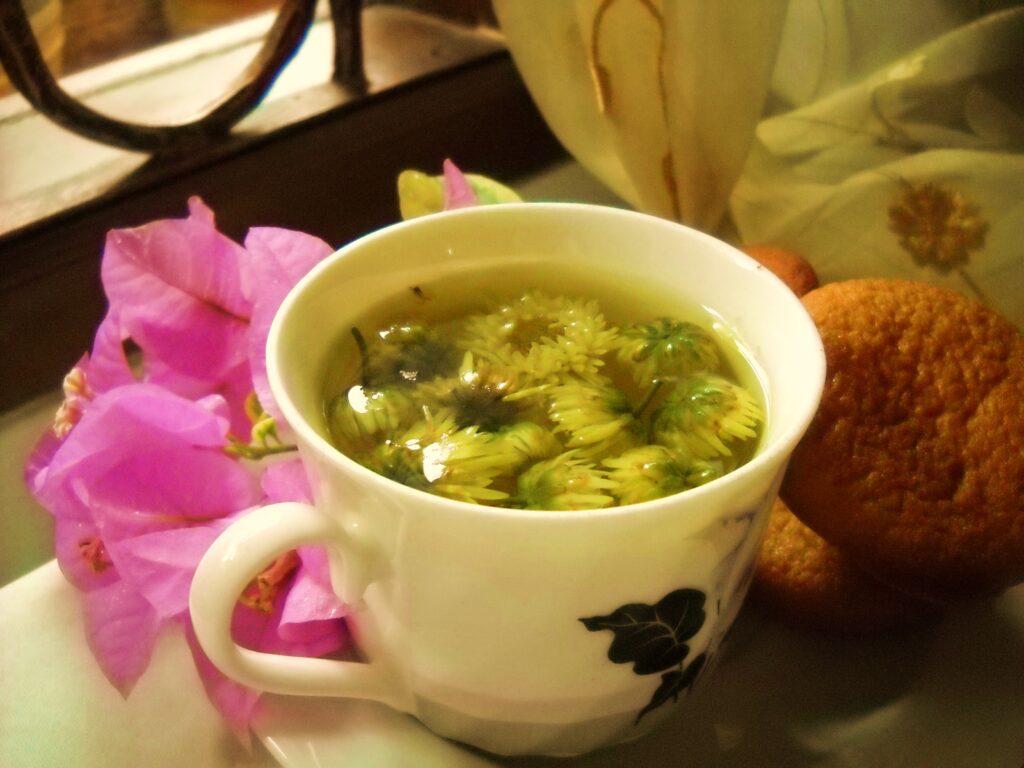
Image: Taman Renyah, CC BY-SA 3.0 https://creativecommons.org/licenses/by-sa/3.0, via Wikimedia Commons
My mother loved to garden. She would spend many summer hours out in the back yard happily trimming and weeding and planting and watering. She grew plenty of annuals, like marigolds and snapdragons in garden beds along the back edge of our lawn, but along the walls of our house, she grew tall perennials, like climbing roses, morning glories, and hollyhocks.
Just outside our back door, she also grew several different colours of chrysanthemum flowers. There were the burgundy ones right outside the door, and then yellow and white chrysanthemums beside them. “Oh, look! My mums are blooming!” I remember her exclaiming one year. She would do the same for the tulips in spring, and the roses in summer, but for some reason I remember her exclaiming about the chrysanthemums in particular that one year. The name just stuck in my head, as it is so similar to the word “Mom”.
I think the connection was also reinforced by the importance chrysanthemum flowers have always had in our business. Chrysanthemum flowers are probably the very first Chinese herb I ever learned, as Julia would always foist bags of freshly dried flowers on us all winter long. One of their main uses is for the prevention and treatment of colds and flu, so Julia was adamant that we have some in our cupboard at all times. If we didn’t have the actual flowers, then she would provide us with packets of chrysanthemum granules to dissolve into cups of hot water.
The anti-bacterial and anti-viral effect of chrysanthemum flowers is so widely known in China that a tea prepared with them is typically served in most Chinese restaurants all winter long in place of black tea. In fact, you can probably use this little fact as an indicator as to how authentic your Chinese restaurant is. The anti-bacterial effect of chrysanthemum flowers has even been backed up by scientific studies, which show they have a particular action against staphylococus aureus, B-hemolytic streptococcus, and shigella sonnei bacteria. They also have an inhibitory effect against leptospira when taken at a high enough dose [1].
Chrysanthemum flowers aren’t just used for cold and flu prevention, though. They are also used for the treatment of headaches, particularly when they occur alongside a viral illness. This is possibly due to their vasodilative effect [2], and may be why they have also been shown to be helpful for coronary artery disease. In one study, 164 patients with coronary artery disease were treated with the equivalent of 50 grams of dried chrysanthemum flowers daily for 2 to 4 months. 86.5% of patients reported an improvement in their symptoms, while 45.3% showed improvement on a subsequent EKG. [3]
Chrysanthemum flowers are also well-known in Chinese medicine for their ability to treat red and inflamed eyes. In fact, they are the most commonly used herb for the treatment of eye disorders in China.
Finally, chrysanthemum flowers are used to lower high blood pressure. In one Chinese study, 24-30 grams each of chrysanthemum flowers and honeysuckle flowers (the combination of herbs used in our Chrysanthemum tincture) was able to reduce high blood pressure after a treatment of just 3 to 7 days. In this case, 35 out of 46 patients showed a reduction in high blood pressure, as well as a decrease in symptoms of dizziness and insomnia that are commonly associated with it. [4]
As the cold and damp weather of late fall starts to descend, there is no better herb to have in your pantry than chrysanthemum flowers. They are so pretty to look at, and their taste is mild and pleasant.
Be aware that their action is quite gentle though, so you will have to use them in great quantity to have an effect. Julia used to recommend drinking at least 2 full pots of chrysanthemum tea daily (about 8 cups). However, when you combine chrysanthemum flowers with honeysuckle flowers, their anti-viral and anti-bacterial effects will be enhanced, so fewer cups of tea should be necessary to achieve the same effect.
- Yi Xue Ji Shu Zi Liao (Resource of Medical Techniques), 1974; (1:2):113.
- Zhong Yao Xue (Chinese Herbology), 1998; 97:99.
- Zhe Jiang Yi Ke Da Xue Xue Bao (Journal of Zhejiang Province School of Medicine), 1978; 4:9.
- Xin Yi Yao Xue Za Zhi (New Journal of Medicine and Herbology) 1972; 2:32.
About the Author: Rebecca Wong has a BA in English Literature from the University of Waterloo and has been working in the herbal business since 2000. She studied at the Ontario College of Traditional Chinese Medicine under respected authorities Paul Des Rosiers and Vu Le, and graduated from the East West School of Planetary Herbology under Michael Tierra. She received training as a yoga teacher at The Branches in Kitchener/Waterloo, and therapeutic yoga teacher training from the School for Somatic Soulwork under Deniz Aydoslu. She now teaches yoga for anxiety, depression and burnout at Rebecca's Restful Yoga Studio in Toronto.
